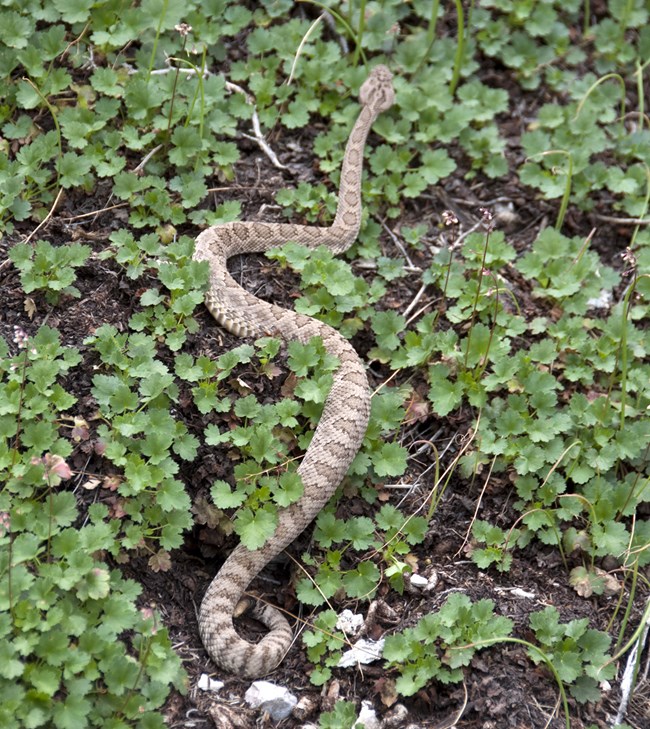Part of a series of articles titled The Midden - Great Basin National Park: Vol. 17, No. 2, Winter 2017.
Article
Rattlesnakes Emerging Earlier Due to Warmer Temperatures
This article was originally published in The Midden – Great Basin National Park: Vol. 17, No. 2 , Winter 2017.

NPS Photo
We conducted a 17-year study of Great Basin rattlesnakes (Crotalus lutosus) at four communal hibernacula in eastern Nevada and western Utah. Surveys were conducted during spring emergence (March, April, and May) from 2000 to 2017. Hibernacula were visited approximately 10 times each year. We defined peak emergence as the date on which the greatest number of snakes were observed at a hibernaculum (sensu Brown 2008).
To determine peak emergence dates, we summed total captures per Julian day, by site and year. We then summed the total captures per Julian day across years and calculated the mean, median, and standard deviation of the dates of peak emergence. We also looked at the relationship between Julian day and mean April temperature using a simple correlation analysis.
Across all years, the mean date of peak captures occurred on 23 April. The mean peak capture date decreased by about one day per year (captures= - 1.1 (year) + 2250, df = F1,15= 7.57, P = 0.009, R2 = 0.3371; Figure 1). This decrease was related to mean April temperature (r = 0.40). Higher April temperatures correlated with earlier emergence dates.

References
Brown, W. S. 2008. Sampling timber rattlesnakes (Crotalus horridus): Phenology, growth, intimidation, survival, and a syndrome of undetermined origin in a northern population. Pages 235-256 in W. K. Hayes, K. R. Beaman, M. D. Cardwell and S. P. Bush, editors. The Biology of Rattlesnakes. Loma Linda University Press.
Chambers, J. C. 2008. Climate Change and the Great Basin. Pages 29-32 in J. C. Chambers, N. Devoe and A. Evenden, editors. Collaborative management and research in the Great Basin — examining the issues and developing a framework for action.
Monahan, W. B., A. Rosemartin, K. L. Gerst, N. A. Fisichelli, T. Ault, M. D. Schwartz, J. E. Gross, and J. F. Weltzin 2016. Climate change is advancing spring onset across the U.S. National Park System. Ecosphere 7:e01465-n/a.
Mote, P. W., A. F. Hamlet, M. P. Clark, and D. P. Lettenmaier 2005. Declining mountain snowpack in Western North America. Bulletin of the American Meteorological Society 86:39-49.
Stewart, I. T., D. R. Cayan, and M. D. Dettinger 2005. Changes toward earlier streamflow timing across Western North America. Journal of Climate 18:1136-1155.
Last updated: March 7, 2024
